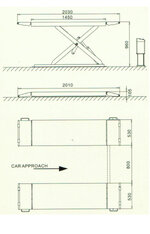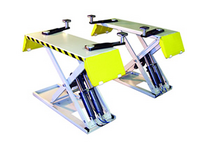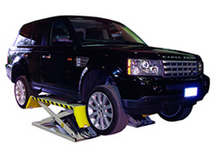NotHandyRandy
Computer
- Nov 5, 2024
- 5
Hello,
Mounting scissor lift
Hi everyone,
I recently acquired a mid-rise scissor car lift rated for 9,000 lbs, and I'm planning to use it for vehicles up to a maximum of 5,500 lbs. Here's a photo of the lift:
 lift dimensions: https://i.ibb.co/CsVGv8QB/IMG-7145.jpg
lift dimensions: https://i.ibb.co/CsVGv8QB/IMG-7145.jpg
Unfortunately, the manufacturer is out of business and there are no official specs or installation guides available.
### Lift Details:
* **Lift Type:** Mid-rise scissor
* **Capacity:** 9,000 lbs - I will do max 5500 lbs
* **Platform Size:** 22” wide x 54” long (each side)
* **Mounting Surface:** Residential garage
* **Concrete Slab Thickness:** is 4" (measured two test holes; for safety at 4 1/2”+ I’m conservatively assuming 4”)
### My Plan:
I'm considering anchoring the lift with **epoxy-set anchors**. I'd prefer to use **5/8” anchors**, but most manufacturers data sheets specify **1/2”** epoxy anchors for 4” slabs.
Interestingly, a U.S. company that sells a
mid-rise 2-post lift allows installation on 4” concrete and includes **5/8” sleeve anchors** — though I’m unsure if sleeves are ideal in this application I could buy those. Brand is Max Jack, two post stresses concrete a lot more no ?
### What I Need Help With:
* Is it reasonable/safe to use 5/8” **epoxy anchors** in a 4” slab?
* Are **sleeve anchors** advisable in this context, or would **epoxy or wedge anchors** be better?
* General advice or best practices you’d follow in this situation?
Thanks in advance for any insights. I know no one here can assume liability, but I’d appreciate experienced suggestions to help me approach this as safely as possible.
Thank you

Mounting scissor lift
Hi everyone,
I recently acquired a mid-rise scissor car lift rated for 9,000 lbs, and I'm planning to use it for vehicles up to a maximum of 5,500 lbs. Here's a photo of the lift:
Unfortunately, the manufacturer is out of business and there are no official specs or installation guides available.
### Lift Details:
* **Lift Type:** Mid-rise scissor
* **Capacity:** 9,000 lbs - I will do max 5500 lbs
* **Platform Size:** 22” wide x 54” long (each side)
* **Mounting Surface:** Residential garage
* **Concrete Slab Thickness:** is 4" (measured two test holes; for safety at 4 1/2”+ I’m conservatively assuming 4”)
### My Plan:
I'm considering anchoring the lift with **epoxy-set anchors**. I'd prefer to use **5/8” anchors**, but most manufacturers data sheets specify **1/2”** epoxy anchors for 4” slabs.
Interestingly, a U.S. company that sells a
mid-rise 2-post lift allows installation on 4” concrete and includes **5/8” sleeve anchors** — though I’m unsure if sleeves are ideal in this application I could buy those. Brand is Max Jack, two post stresses concrete a lot more no ?
### What I Need Help With:
* Is it reasonable/safe to use 5/8” **epoxy anchors** in a 4” slab?
* Are **sleeve anchors** advisable in this context, or would **epoxy or wedge anchors** be better?
* General advice or best practices you’d follow in this situation?
Thanks in advance for any insights. I know no one here can assume liability, but I’d appreciate experienced suggestions to help me approach this as safely as possible.
Thank you



